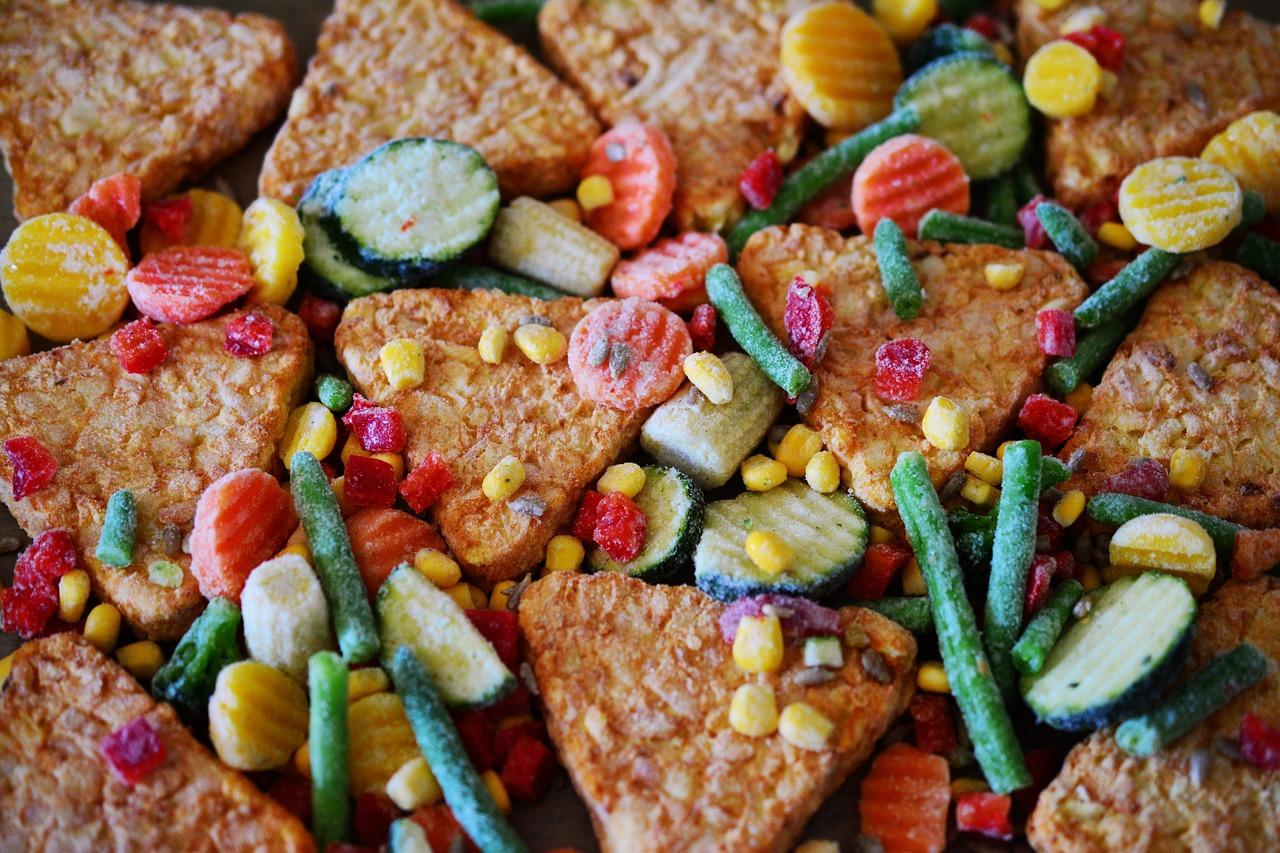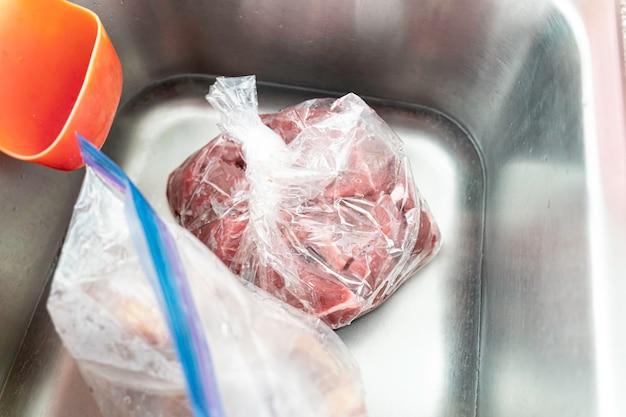Life can get busy, and there are times when we forget to take out the frozen food in advance for dinner. We’ve all been there, right? So, what’s the best way to quickly thaw frozen food without compromising its taste, texture, or safety? In this blog post, we’ll explore various methods for thawing frozen food and answer all your burning questions about defrosting.
From using the microwave to leaving meat out on the counter, you might have heard of several methods, but which one truly stands out? We’ll dive into the safest and most efficient ways to thaw meat and other frozen foods, making your meal preparation a breeze. Along the way, we’ll address common concerns, such as bacteria growth and the impact of different temperatures on the thawing process.
So, if you’ve ever wondered how to thaw frozen food quickly or why thawing in hot water is a bad idea, keep reading. Get ready to unlock the secrets to perfectly thawed food, ensuring both deliciousness and safety. Let’s explore the best methods for thawing frozen food in this comprehensive guide.

Best Methods for Thawing Frozen Food
So, you’ve got a freezer full of delicious frozen food, and now it’s time to defrost it. But what is the best way to go about it? In this section, we’ll explore some of the most effective methods for thawing frozen food. Get ready to thaw like a pro!
Thawing in the Fridge – The Slow and Steady Approach
One tried and true method for thawing frozen food is to simply pop it in the fridge and let time do its magic. This method requires patience, as it can take several hours or even overnight for larger items to fully thaw. But hey, good things come to those who wait!
Thawing in the fridge is a safe and reliable method that helps maintain the quality and texture of your food. However, if you’re in a hurry, this method might not be the best option for you. So let’s explore some faster alternatives!
Cold Water Bath – Quick and Splashy!
When time is of the essence, a cold water bath can come to the rescue. Fill up a sink or large bowl with cold water, seal your frozen food in a leak-proof bag, and submerge it in the water. It’s like giving your frozen food a refreshing spa treatment!
Be sure to change the water every 30 minutes to keep it cold, ensuring a consistent thawing process. Remember, we want the water cold but not warm. We’re thawing here, not cooking! This method is great for smaller items like individual portions of meat or fish.
Microwave – Zap it to Thaw it!
If impatience is your middle name, then the microwave might be your go-to thawing method. Most microwaves have a defrost setting, which allows you to thaw your frozen food with a few button presses.
But be warned, thawing in the microwave can be a bit tricky. Uneven thawing can occur, leaving you with partially defrosted food in some areas and overcooked or cooked edges in others. So, it’s crucial to monitor the process closely and rotate your food as necessary to promote even thawing.
Cooking from Frozen – For the Bold and Adventurous
Now, here’s a method that requires some bravery and culinary skills – cooking your frozen food straight from the freezer! This method may seem unconventional, but it can be a time-saving option when you’re feeling bold.
However, keep in mind that not all frozen foods are suitable for direct cooking. Some items, like large cuts of meat or thick casseroles, might not cook evenly or thoroughly without a proper thawing process. So be sure to check the cooking instructions on your food packaging to ensure it’s safe to go from freezer to oven or stovetop.
There you have it – a breakdown of some of the best methods for thawing your frozen food. Whether you choose the slow and steady fridge method, the quick and splashy cold water bath, the zapping powers of the microwave, or the bold and adventurous cooking from frozen, now you’re armed with the knowledge to defrost like a pro!
Remember, the method you choose will depend on factors such as time, food type, and your level of patience. So go ahead, thaw your frozen goodies with confidence, and enjoy your meal without the icy surprises!

Thawing Frozen Food: Your Questions Answered
Welcome to our FAQ-style guide on the best methods for thawing frozen food. We’ve compiled a list of the most commonly asked questions about defrosting, so you can thaw your favorite foods with ease. From quick thawing techniques to the safest methods of thawing meat, we’ll cover it all. Let’s dive in!
How do you thaw frozen food quickly
If you’re in a hurry to thaw your frozen food, there are a few speedy methods you can try:
- The Cold Water Bath: Place your food in a leak-proof plastic bag and submerge it in cold water. Change the water every 30 minutes until thawed.
- The Microwave Method: Use your microwave’s defrost setting. Be sure to follow the recommended timings for different types of food to avoid any unwanted cooking.
How can I defrost ground beef quickly
Ah, the trusty ground beef! To defrost it in a hurry, you have a couple of options:
- The Cold Water Soak: Seal the ground beef in a plastic bag, submerge it in cold water, and change the water every 30 minutes until it’s thawed.
- The Microwave Approach: Use your microwave’s defrost setting. Just make sure to keep an eye on it to prevent any unwanted overcooking.
Which is the safest method of thawing meat and why
When it comes to safety, the refrigerator method takes the crown! Here’s why:
By thawing your meat in the refrigerator, you allow it to defrost at a safe and consistent temperature. This is important because it prevents any parts of the meat from reaching the danger zone where bacteria thrive. Plus, it helps maintain the meat’s quality and taste. Slow and steady wins the race!
Do microwaves kill bacteria
Yes, they do! Microwaves can help kill bacteria during the cooking process. However, when it comes to defrosting, microwaves may not always thaw food evenly. That’s why it’s important to follow the recommended defrosting times and give your food a thorough check before cooking.
Can you put meat outside to defrost
While the thought of letting nature work its magic might be tempting, it’s best to steer clear of defrosting meat outside. Leaving meat outside can lead to uneven thawing, making it a breeding ground for bacteria. To keep your food safe and avoid any unwanted guests (we’re talking about you, bacteria), it’s best to stick to the recommended thawing methods.
At what temperature do germs die
While germs can be pesky little creatures, they don’t withstand heat very well. Most bacteria start to perish around 165°F (74°C), so make sure your food reaches this internal temperature to ensure you’re germ-free and good to go.
How do you safely thaw frozen meat
For safe meat thawing, follow these simple steps:
- Refrigeration: Thaw your meat in the refrigerator at a temperature below 40°F (4°C). It may take a bit longer, but it’s the safest method.
- Cold Water Bath: If you’re in a rush, submerge your meat in a sealed plastic bag in cold water. Change the water every 30 minutes until it’s thawed.
- The Microwave Modus: Use the microwave’s defrost setting, but remember to cook immediately afterward to prevent any bacteria from having a second chance.
Can I leave chicken on the counter to thaw
No, no, no! We may have heard that “patience is a virtue,” and it’s especially true when it comes to thawing chicken. Leaving chicken on the counter can lead to rapid bacteria growth and put you at risk of foodborne illnesses. Instead, opt for the refrigerator or cold water methods to safely thaw your poultry.
Can you brown frozen ground beef
Well, you can try, but it won’t be a walk in the park! When you attempt to brown frozen ground beef, you’ll likely end up with cooked sides and a frozen center. To ensure even cooking and avoid any undercooked surprises, it’s best to thaw your ground beef before browning.
What foods kill bacteria
While no food has superhero powers that can kill all bacteria, there are a few that can help combat those pesky germs:
- Hot Tea: The heat and compounds found in tea can have a positive impact on bacterial growth.
- Garlic: This flavorful bulb not only keeps vampires away but also has antimicrobial properties that can help tackle bacteria.
- Vinegar: From salads to cleaning surfaces, vinegar has been used as an antimicrobial agent for centuries. However, we don’t recommend drinking it straight from the bottle!
What are the four acceptable ways to thaw food
You’re on the right track! The four acceptable methods to thaw food are:
- Refrigerator: The safest way to thaw food, allowing for slow, controlled defrosting.
- Cold Water Bath: A quicker method that requires changing the water every 30 minutes.
- Microwave: A convenient option but can result in uneven thawing, so be cautious.
- Cooking: You can also cook your frozen food directly, allowing it to thaw as it cooks. Just be mindful of cooking times to avoid any unwanted crispiness.
Why is thawing meat in hot water bad
While hot water may work wonders elsewhere, it’s a big no-no when it comes to thawing meat. Thawing meat in hot water raises the temperature to a level where bacteria can multiply rapidly, increasing the risk of foodborne illnesses. To keep your food safe and healthy, stick to the refrigerator or cold water methods.
Does cooking meat kill bacteria
Absolutely! Cooking meat at the recommended temperatures kills off harmful bacteria, making it safe to consume. Just be sure to use a food thermometer to check that the internal temperature has reached the recommended threshold for the specific meat you’re cooking.
How do you thaw under refrigeration
Thawing under refrigeration is as easy as apple pie. Follow these steps:
- Place your frozen food in a leak-proof plastic bag to prevent any unwanted cross-contamination.
- Put the bag on a plate or tray to catch any condensation.
- Pop it into the refrigerator and let it work its magic. Remember, patience is key here as it may take a bit longer than other methods.
That wraps up our comprehensive FAQ-style guide on the best methods for thawing frozen food. We hope these answers have shed some light on the murky realms of defrosting. Stay safe, keep those taste buds happy, and enjoy your thawed delights!
